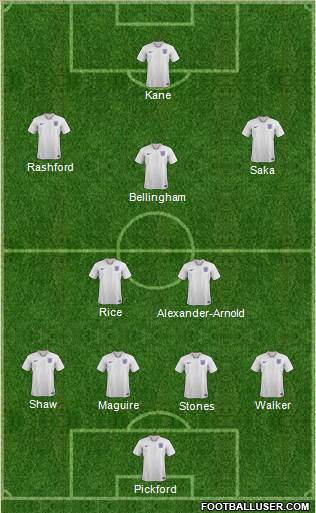
England Football Formation
Lineup (4-2-3-1)
Pickford · Stones · Maguire · Walker · Shaw · Alexander-Arnold · Rice · Bellingham · Saka · Rashford · KaneBuilds on current England formation with Trent A-A adopting the right-sided DMF role to provide the range of passing to the forwards, plus a top-shelf direct freekick taker. Rice and Trent A-A to alternate moving forward to join attacks and overload the opposition in the final third. Additional option in possession for any of the back line to roam forward and move to a back three, as all can (and have) play CB; if Stones was to step into DMF as he does for City, Trent A-A could then move forward again and take up a second number 10 alongside Bellingham. This represents a far more sophisticated option for England if in search of a last-minute goal, rather than adding numbers to the forward line at the expense of the midfield. Foden directly interchangeable with Saka, Grealish with Rashford, Maddison with Bellingham (utilising these top players in their natural positions, as opposed to being tempted to deploy in midfield, under-utilise their skill-set and have to restrict Rice to a sitting DMF role to make up for reduced defensive cover). Maguire retains the left-sided CB role to provide forward runs and range of passing for England. An alternative option with a similar profile is Dunk; albeit he is less experienced in major tournaments. Whilst it is tempting to attempt to play the best players in the same 11, with this approach England can afford to rotate most of the starting line-up throughout the Euros without compromising on quality. This system also represents a natural evolution for the players, with Bellingham now suiting a left-sided roaming number 10, and Alexander A-A increasingly comfortable as a right-sided DMF, where England need a creative presence. Contrary to this system being defensively focussed, with this personnel it actually holds the greatest potential for hugely effective transition and retention of the ball in the final third. Southgate's blueprint is based on the rebuild of the German national team in 2006, which saw the promotion of U21s to the senior side and a 4-2-3-1 formation, with a sweeper keeper, attacking full-backs, a double-pivot with 1 holding and 1 quarterback-style pairing in DMF, a creative number 10 and two wide forwards either side of the striker. This became the young German team which caught the eye at the 2010 World Cup and went on to win the 2014 World Cup. Whilst the profile of England's players is different to the German teams of 2010 through 2014, counter-attacking moments in recent England matches show how close the team are to realising the potential of this system. Given the technical quality of the players available to England, and the coaching many of the key players currently receive at club level, this could even evolve into something which incorporates some of the overloading tactics commonly employed at Man City, Liverpool and Arsenal, even if for moments in a game. Once the key personnel is established, and the squad is practised enough in this system, the result could bring England to the point of domination for years to come.